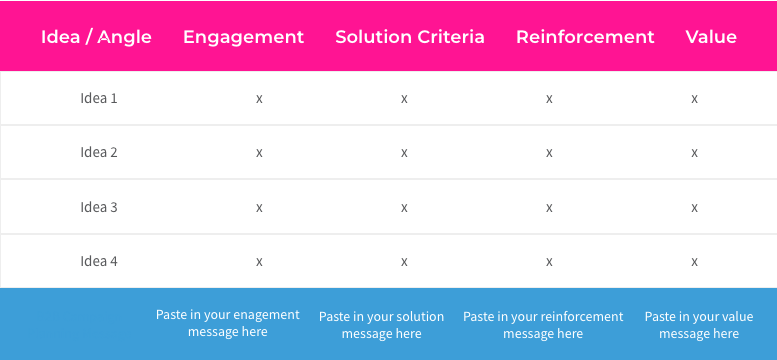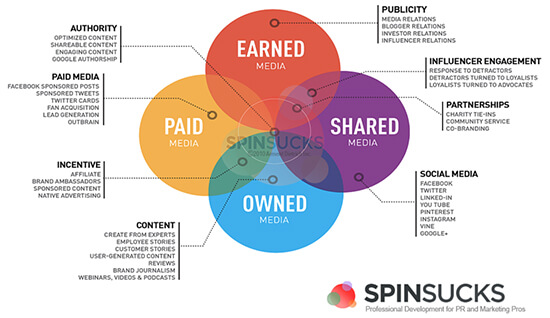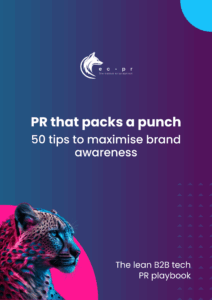
A complete guide to B2B PR campaign planning for 2024/25
Everything you need to know for successful B2B PR campaign planning
A strategic PR guide for B2B Marketers to help execute your communication strategy
Discover how to create a B2B campaign plan which successfully delivers your communication strategy. We guide you through:
- tailoring creative messaging to each stage of the customer journey,
- selecting the right media channels to reach your target audience,
- understanding the media landscape and benchmarking your performance against competitors,
- and choosing the right spokespeople to scale your marketing efforts.
We also explore key trends shaping B2B campaign planning in 2024.
What is a B2B PR campaign plan?
Your communication strategy provides you with your overarching, strategic approach, whilst your PR campaign plan should flesh out the details of:
- how it will be delivered,
- where and when it will be communicated
- and who will be responsible for delivering it.
Before you begin campaign planning
Always begin with the initial task of setting out some clearly defined PR objectives which should be closely aligned to, and intended to achieve, the overarching goals of the business, as set out in your communication strategy.
There are many goals your PR campaign may want to achieve, including those such as increasing brand awareness, promotion of a new product, more involved engagement, or simply having a bigger share of voice in the market.
The 5 steps to B2B PR campaign planning

Turn your messaging into brilliant ideas

Choose your media channels

Understand your place in the media landscape

Choose your spokespeople

Launch your campaign
Creative messaging for the customer journey
Every customer goes through a customer journey, before committing to purchase from you. The journey we used to call a ‘marketing funnel’, but more recently, since customer interactions have become more fluid and extensive online, through many different channels and touchpoints, this may be better expressed as a ‘Discovery loop’.
Your customers’ journeys may each differ in the length of time, and in the places where they notice or interact with your company, so be aware that the stages shown below can be blurred. However, as marketers you should decide the likely rationale your prospects have and offer corresponding messaging accordingly, which should already be captured in your communication strategy.
Customer journey
- Engagement phase: where you’re developing trust and authority.
- Solution phase: here you’re building rapport and credibility.
- Reinforcement phase: you’re securing interest and preference
- Value phase: you’re demonstrating how their life will improve by using your product/service.
Therefore when B2B PR campaign planning you should know what to say at each stage of the buying cycle, but how do you turn this messaging into creative ideas for compelling content?
The EC-PR approach is to create a ‘Brilliant Ideas Bank’ (BIB) to hold all your initial ‘seed’ ideas for development. You can also call this customer-centric content.
Create a BIB in 4 easy steps
1 Create a table for each target persona
2 In the first column you are going to jot down your seed idea. In columns #2 to #5 you will indicate which message the seed ideas most closely support
3 Each seed idea should be no more than a headline to begin with. It is often helpful to frame it as a question.
4 For each message, consider the key phrases and write down as many questions about that phrase that a buyer might ask. Don’t assume your buyer has any in-depth level of knowledge and expertise.
For more BIB examples and tips, download our complete guide here.
Choosing your media channels
The next stage of your campaign planning is to ensure the appropriate messages are served to the right person, at the right stage of their journey, in the most appropriate format and via channels where your buyers are present.
There are four stages to the traditional buying cycle. In 2024 we are conscious that the customer journey is unlikely to be linear as depicted in the AIDA model below, but we find this is still a clear tool to help marketers organise their content creation. Simply consider this model to be flexible and porous – people may enter, exit and revolve around these stages, noticing your brand, following it, filing away for later, engaging with it or not, until the time they want to enquire, purchase or even refer you.
1
Awareness
2
Interest
3
Desire
4
Action
Your target buyers may move or loop through these stages at different speeds. So, you need to give them the opportunity to become familiar with your brand at a pace that is right for them, which means you need to be ever present.
A most valuable point of reference in your communication strategy is where your target market ‘hang out’. Where do they spend their time and go for their information? This information, which you should have collated, will guide you in terms of where your messages need to appear.
The four different types of media channels from which to choose from are paid, earned, shared, and owned; often referred to as the PESO model®, created by Gini Dietrich of Spin Sucks.
Owned media
Owned media channels are the channels that belong to your brand and include your marketing assets, website content, social posts and blogs. You have complete ownership of your owned media, so these channels should be consistent, on-brand and on-message.
Earned media
Earned media opportunities are the 3rd party opportunities you’re given, to share your achievements, opinion or thought leadership. These are when you’re being invited to contribute, as someone looks to you as an industry authority, who people will find interesting and engaging.
Paid media
Paid media are the channels you pay for, for your content to appear on them, such as digital advertising, radio, TV etc. The content is created and controlled by you, but it appears on channels your brand doesn’t own or control.
Shared media
Shared media is a term referring to the share-ability of social media. With the whole world now online, a visible online presence is required in order for your brand to be valued and understood.
An integrated approach
At EC-PR, we’re huge advocates of an integrated, ‘converged media’ approach, as PR is in fact media neutral. PR embraces any channel which helps to further a brand’s reputation. The key is to be involved and engaged in all four channels because they represent a high mix of high and low trust media, which will make your comms credible.
Download our guide and get the perfect media blend
In our Definitive B2B PR Campaign Planning Guide we’ve included an example of how to select the best media blend for your business.
Understand your place in the media landscape
B2B publications, both print and online, represent a ‘high trust’ channel and the business case for media coverage is well documented. Our own article explaining the business case for B2B PR tech scale ups illustrates how media coverage builds brand awareness, credibility and trust among your target audiences. Another take on this is Forbes’ article on how PR is playing a crucial role in the evolving B2B PR landscape.
To measure your progress, you need to create a benchmark and you do this by evaluating how you are performing on key messages and against your main competitors, in your most influential publications. Measure whether your key messages have been covered by your top publications in the last six months. Compare that to your competitors’ performance in the same reports or articles. Did they also get mentions? And how did your messaging overlap, or not? This exercise will give you an initial benchmark against which you can then score your performance as time goes on.
Choose your spokespeople
Effective B2B PR needs people to speak for your business! Tech PR particularly needs subject matters experts to deliver a good interview. This means answering the question, delivering interesting insight and weaving in key messages while also being engaging. So, as part of B2B PR campaign planning, you may need to discover and train the right spokespeople to be the face of your campaign.
To evaluate whether your subject matter experts could be a suitable spokesperson, you can conduct this ‘quick and dirty’ exercise.
Invite the nominated expert to an internal meeting to talk about a given area of their expertise for 12 minutes. You want to know the: what, why, where, when and how of a particular issue as well as what your company or brand can do to resolve or improve the situation. This is a total of six questions.
Then assess their suitability by asking:
1 Was the answer to the question clear?
2 Was the answer to the question appropriately concise?
3 Was the answer interesting?
4 Was the delivery engaging?
5 Was the company solution proposed with conviction and clarity?
This isn’t for everyone, but hopefully you’ll find some great candidates. Investing in spokesperson and media training for technical experts can also be a worthwhile investment during this PR campaign planning activity.
Launch your campaign
Once you have followed steps 1-4 you will have set your benchmark, selected your media channels, developed a bank of seed ideas for future content and settled on a process for selecting your nominated spokesperson.
Only once these steps are complete will you be ready to move on to the campaign delivery phase – the phase that shifts from strategy to tactics as you look to research, build and distribute compelling content that your clients and prospects will love.
5a The content calendar
It is a written schedule of when and where you plan to publish upcoming content. Typically your content calendar will include upcoming pieces including blogs and insights, status updates, planned promotional activity, partnerships, industry events and key dates as well as any updates to existing content.
Now it’s all down to the delivery!
By following this process you have equipped yourself with assets that speak to your target audiences and you will have a PR campaign plan of engagement rooted in messaging that will appeal and inspire them. Your campaign plan has been designed to deliver your business objectives as specified in your communication strategy. Disciplined and methodical delivery of your plan will ensure you make strides to achieving your goals.
What a B2B PR agency gives to your marketing team
We love marketing teams and our job is to give them the extra PR power they need. Partnering with a B2B PR agency gives you expert guidance in targeting business audiences, securing media coverage, and building industry relationships. You will benefit from our years of establishing relationships with industry media and influencers, ensuring your brand gains visibility through well-placed coverage. A PR agency can create and execute tailored PR strategies, including content and crisis management, to align with your business goals.
B2B PR campaign planning trends to watch out for in 2024
Here are three trends to consider when campaign planning in 2024.
1. Data-driven PR campaigns and measurement: The use of data analytics to shape PR campaigns is becoming more prevalent. Companies increasingly rely on data to understand target personas, measure campaign effectiveness, and optimise content strategies. At EC-PR we have developed and tested our PR Measurement programmes using the most robust data capture and measurement techniques that we’ve ever had. See more on our PR Measurement page.
2. Using artificial intelligence in content creation: AI-driven content creation tools have quickly impacted how PR teams develop and distribute content, as well as how our clients work. Therefore, learning how to use AI in PR is essential to keep up with competitors but not dismay journalists!
3. Thought leadership and personal branding in tandem: Establishing executives and subject matter experts as thought leaders will continue to be a strong trend, but the channels where this happens have evolved. B2B brands are increasingly focusing on developing thought leadership content that positions their leaders as industry authorities with a more approachable human side. Exectuives who can engage, inspire and collaborate using platforms like LinkedIn, Reddit as well as conventional industry forums and publications will rise above the rest.
At EC-PR we are passionate about B2B communication. We believe your work is amazing and we want to help you tell the world how extraordinary it is. Get in touch.

B2B PR Campaign Planning Guide
Your complete guide to creating compelling PR campaigns & content







